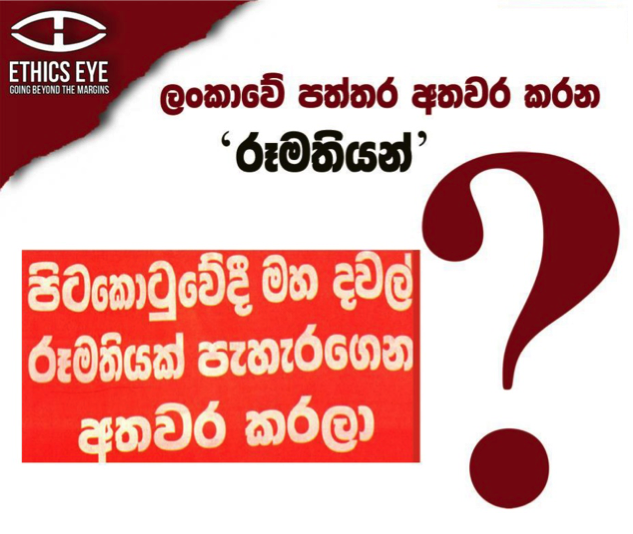Featured image courtesy IPS News
Sri Lanka’s media continues to deviate from established standards of ethical journalism. This includes graphic pictures, misleading photos and commentary of events, racial labels used selectively against ethnic groups, factual errors and the denial of ‘right of response’ in reporting. Accordingly, the representation of women in Sri Lankan media over the years has breached many ethical standards, resulting in the reinforcement of negative stereotypes. This stereotyping can directly influence how women are perceived in society.
In this context, this article offers observations on the portrayal of women in the Sinhala print media based on data from Ethics Eye, a platform that monitors and flags violations of media ethics in seven Sinhala newspapers: the Dinamina, the Divaina, the Lankadeepa, the Mawbima, Sunday Divaina, Sunday Lankadeepa and the Sunday Mawbima.
The sexual objectification of women in Sinhala newspapers
Some mainstream Sinhala newspapers in Sri Lanka violate this ethical guideline by portraying women as sex objects. Women are frequently objectified in the press with the use of sexist references and pictures. These references are often ones that expose semi-nudity, which are irrelevant to the context of the article. For example, one Sinhala newspaper referred to a woman as “baduwa” in one of their columns, insinuating that women are sex objects. The same newspaper identified all actresses in Sri Lanka as engaging in “the oldest profession in the world”, depicting them all as sex workers.[1]
Further, a series of articles published in one of the mainstream Sinhala newspapers carried images of foreign women in bikinis, which were irrelevant to the story they were reporting. The series did not carry a disclaimer to indicate that the photographs – taken with long-lens cameras – were taken without consent. As stated in the Code of Professional Practice published by the Editor’s Guild of Sri Lanka, the use of long-lens or other cameras to photograph people without consent on private or public property where there is a reasonable expectation of privacy is unacceptable – unless in the public interest.

At the same time, the same newspaper that referred to all actresses as sex workers also upheld women as the ‘guardians of cultural and moral values’ in another article. This comment was in criticism of the gazette notification issued by the Ministry of Education, banning the imposition of dress codes for women entering public and private schools.
Reductionist terms such as “beautiful” are used in the press, especially when referring to rape victims and survivors. The physical appearance of female victims and survivors of rape, accidents or other incidents is referred to in many articles in the Sinhala press. The reporting of unconnected, unnecessary details, such as physical appearance, when it is not directly related to the story is a common occurrence in Sinhala newspapers. For example, when two female students died from a train accident in Dehiwela last year, six out of seven Sinhala newspapers referred to their physical appearance when reporting the incident.

The use of such terms, which are both irrelevant and sexist, raise serious questions on the extent to which the media in Sri Lanka fulfill its ethical obligations.
The objectification of women in the press reinforces stereotyping of women. Moreover, the sexual objectification and damaging representation of women in the media leads to the trivialisation of violence against women. The Guardian recently found that the sexualisation and objectification of women and girls in the media are linked to the development of sexist attitudes in society and the acceptance of masculine ideologies that objectify women.[2]
Violence against women sensationalised
In dealing with social issues of a particularly shocking or emotionally painful nature – such as violence and drug abuse – the Code of Professional Practice states that the press should take special care to present facts, opinions, photographs and graphics with due sensitivity and discretion, subject to its duty to publish in the public interest. However, some Sinhala newspapers violate this guideline by sensationalising and romanticising news when reporting on acts of violence against women, such as rape and sexual abuse. For example, some papers referred to the suspect or perpetrator of sex crime as a “cupid”, a term which romanticises them. At the same time, victims and survivors of rape are often blamed for the attire they wore or for being at the wrong place at the wrong time.
When newspapers hold women accountable for rape, it not only adversely affects the way society views women but also promotes the impunity of perpetrators of violence against women.
In its attempt to sensationalise a story to make it more enticing to an audience, the media neglect the important role it plays in creating awareness about sex crimes. Rape, domestic abuse and other forms of violence are a taboo subject in society and go unreported in many cases. Sensationalising these acts in reportages takes attention away from important aspects such as the prevention and mitigation of such crimes. This includes awareness about helplines for victims of sexual abuse as well as the existence of organisations dedicated to helping women who have experienced sex crimes.
What can be done?
The first step towards fixing this issue is creating awareness about the ethical violations committed by newspapers in reporting on women. On International Women’s Day 2017, Ethics Eye released a video highlighting some of the ethical guidelines violated by Sinhala newspapers in this regard. Furthermore, triggering a discussion around ethical violations in the media and spreading awareness around them gives the public the information it needs to hold journalists and editors answerable to their mistakes and damage caused by harmful reporting. Moreover, training journalists on media ethics, including on reporting on women in a manner that is not discriminatory and sexist, is urgently needed in Sri Lanka.
[1] See the Ethics Eye Facebook page for further reference
[2] http://image.guardian.co.uk/sys-files/Guardian/documents/2009/05/29/joiningupthedots.pdf

